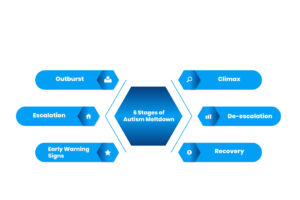Autism meltdowns are a significant part of life for many individuals with autism spectrum disorder (ASD), often arising from overwhelming sensory input or emotional distress. However, these episodes might be intense and difficult. So, it is possible to make a big difference in both the individual and their caregiver’s well-being by learning how to manage autism meltdowns effectively.
Meltdowns usually arise from sensory overload, communication breakdown, or emotional upset, and they can be expressed in many different behaviors, from physical displays to total withdrawal.
In this thorough guide, we’ll discuss what autism meltdowns are, their reasons, typical symptoms, and most importantly, how to manage autism meltdowns in various situations, such as autism meltdown toddler, autistic meltdown adults, and extreme autism meltdowns. Regardless of whether you’re a caregiver or parent, knowing about meltdowns is crucial to ensuring proper support.
What is Autistic Meltdown?
An autism meltdown is a powerful, overwhelming response to stress, anxiety, sensory overload, or frustration felt by a person with autism. Meltdowns may come out in various ways, including crying, screaming, aggression, or self-injury. Meltdowns should be known not as intentional behaviors or tantrums, but as an effect of something that the person cannot manage in the moment.
In addition, autistic meltdowns are also a lot misunderstood, particularly when it comes to distinguishing them from other emotional reactions such as tantrums or defiance. A severe autism meltdown is also especially challenging to both the individual and those who are caring for them or loving them.
Autism Meltdown Symptoms
Autism meltdown symptoms vary depending on the individual, but typically include signs of distress such as:
- Crying or screaming
- Aggression, including hitting, kicking, or biting
- Verbal outbursts or shouting
- Withdrawal or refusal to engage
- Clinginess or needing constant reassurance
What Causes Autistic Meltdowns?
Knowing what causes autistic meltdowns is essential for avoiding or coping with them. The most frequent causes are:
- Sensory Overload: Most people with autism are over-sensitive to sensory input, like bright lights, loud sounds, or pungent odors. This sensory overload can cause a meltdown.
- Communication Challenges: Failing to communicate wants or feelings may give rise to frustration, which may finally result in a meltdown.
- Routine Changes: Autistic people generally love routine. Any sudden change or interruption in routine will cause them anxiety and result in a meltdown.
- Social Interactions: Trouble with social interactions or communication misunderstandings can be a main trigger.
What are the 6 Stages of Autism Meltdown?

1. Early Warning Signs
The initial indication of a meltdown is usually minor behavioral changes, for example, growing anxiety, restlessness, or irritability.
2. Escalation
The person becomes more upset, and their emotional intensity increases. They may show anger or confusion, which is an indication that they are starting to feel overwhelmed.
3. Outburst
This is when the meltdown peaks. The person might scream, cry, throw objects around, or exhibit aggressive behaviors. This phase can be extremely hard to handle.
4. Climax
The meltdown is at its most intense level. During this phase, the person might be totally overwhelmed, and the behavior can become risky to themselves and other people.
5. De-escalation
Following the peak, the intensity starts to ebb, and the person becomes more aware of their environment. During this stage, they may show signs of confusion or fatigue. Gentle reassurance and a quiet space help them regain control.
6. Recovery
The person may become exhausted or shut down emotionally, then may enter a calm stage. They might feel embarrassed, drained, or withdrawn. Offering empathy, patience, and understanding is crucial here. This is also a good time to provide emotional support, hydration, and a sense of security to help them fully recover.
Signs of Autism Meltdown in Girls
Autism meltdowns are more commonly linked with boys; girls also experience them, but possibly in a different manner. Girls with autism tend to suppress their emotions or behavior, and hence, delay the identification of meltdowns. Some of the signs of autism meltdown in girls are:
- Withdrawing or shutting down emotionally
- Bursts of sudden outbursts or emotional breakdowns
- Handle sensory input, including bright lights or loud noises
- Physical indicators, including tight muscles or frozen gaze
High-functioning Autism Meltdown Child
A High-functioning autism meltdown child might appear to manage everyday tasks easily but have difficulty managing their emotions, particularly in high-stress situations. Such children can appear placid on the outside but might be brewing inner trouble. When they hit their breaking point, the meltdown will seem worse due to the fact that they had been trying to keep it together for so long.
Furthermore, parents and caregivers need to recognize that just because a child seems “high-functioning,” that does not necessarily mean they’re not suffering from extreme stress or sensory overload, which ultimately can result in a meltdown.
How to Handle Autism Meltdowns?
Learning how to deal with autism meltdowns is important for family members and caregivers. Here are some effective ways:
1. Offer a Safe Place
If one can, walk the person towards a quieter room outside of sensory input areas. This might dilute the severity of the meltdown.
2. Employ Visual Supports
If the person cannot communicate, visual cues (such as picture cards or a communication board) will assist them in communicating their wants.
3. Provide Comforting Objects
A comforting object, such as a favorite toy, blanket, or calming music, can be used to calm a person during or after a meltdown.
4. Don’t Physically Restrain
Unless it is to avoid injury, don’t physically restrain the person. This can escalate the situation and cause further distress.
5. Let Time for Recovery
Once the meltdown has passed, allow the person to come down fully. Hurrying them through the process can do more harm than good.
How to Calm Down an Autistic Child Having a Tantrum?
A tantrum and a meltdown might look alike, but the reasons are not. A tantrum is generally an attempt to exert control, whereas a meltdown is an emotional response to too much stimulation. To how calm down an autistic child having a tantrum, it’s necessary to treat the underlying reason, which could be:
- Minimizing external stimuli (lights, noise, etc.)
- Using clear and consistent communication
- Providing a sensory break, such as spending time with a favorite toy or activity
- Prompting deep breathing or other relaxing strategies
- Diverting their attention to a relaxing object or activity
Calming Medication for Autistic Child
In certain situations, calming medication for autistic child might be ordered to assist with anxiety or other associated conditions that help cause meltdowns. Therefore, medications like selective serotonin reuptake inhibitors (SSRIs) or atypical antipsychotics help stabilize mood and curb impulsivity. But always consider medication within a more comprehensive, customized treatment plan, such as behavioral therapy and other treatments.
ADHD Meltdown Vs Autism Meltdown
ADHD meltdown vs autism meltdown has subtle but crucial differences. However, both may present with emotional explosions and trouble with self-regulation, with external circumstances or activities. In contrast, autism meltdowns tend to be precipitated by sensory overload or trouble processing feelings. Understanding these differences can aid caregivers in establishing suitable interventions for each case.
BPD Meltdown vs Autism Meltdown
Likewise, a BPD meltdown vs an autism meltdown draws attention to the various underlying reasons. Borderline Personality Disorder (BPD) constitutes extreme emotional responses usually involving abandonment or rejection anxiety, while autism meltdowns usually arise from sensory overload, communication issues, or breaking of routine. The underlying cause of each meltdown type is significant for successful intervention.
How to Help an Autistic Meltdown?
To help with an autistic meltdown, you must focus on reducing the stressors causing the meltdown. This could involve:
- Giving the individual space and time to cool down
- Removing any environmental triggers
- Providing emotional support through calming gestures or words
- Using consistent and predictable routines to prevent future meltdowns
End Note
In conclusion, autism meltdowns are difficult situations that are usually overwhelming to the autistic and their loved ones. Having information about the causes, symptoms, and stages of autism meltdowns will equip the caregivers with the ability to manage such instances in a better way and enable the individual to overcome them. It refers to an autism meltdown toddler, in high-functioning autism meltdown children, or in adults. Still, in either case, it is essential to be patient, to be empathetic, and to have the strategies to deal with such difficult situations. For an autism spectrum treatment, reach out to MAVA Behavioral Health!
FAQs
What is an autism meltdown?
An autism meltdown is a reaction to excessive sensory, emotional, or social stimuli and usually results in extreme behaviors (such as crying, screaming, or hostility).
What is the cause of autism meltdowns?
Sensory overload, frustration because of communication difficulties, unexpected routine change, increased stress, and anxiety may trigger meltdowns.
What do I do to know when my child is in an autism meltdown?
Symptoms of a meltdown can be crying, screaming, aggressiveness, withdrawal, stimulation, or self-harm, which are often precipitated by excessive situations.
What happens to be the duration of autism meltdowns?
Meltdown may take a range of a few minutes up to more than an hour, depending on the individual and the intensity of the meltdown.
Is it possible to experience autism meltdowns in adults?
Adults can have autism meltdowns, which are usually caused by stress, sensory overload, or social events, and are not typically the same as those in children.









